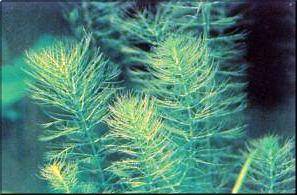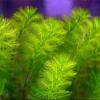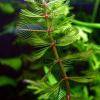Myriophyllum hippuroides
Scientific name: Myriophyllum hippuroides
Family: Haloragaceae
Maximum size reached under cultivation: 50 - 60 cm (19.69 - 23.62 inch)
014
Recommended pH range: 6.5 - 7.2
Recommended water hardness: 4 - 12°dGH (71.43 - 214.29ppm)
0°C 32°F30°C 86°F
Recommended temperature range: 20 - 25 °C (68 - 77°F)
Preferred propagation method: Cuttings
Native to: North America
Growth rate: Normal
Recommended substrate: Fine gravel
Lighting requirements: Bright
Ideal placement in tank: Background
Common Name
Water Milfoil
Origin
Myriophyllum hippuroides is native to North America, particularly found in the western United States, including states such as California, Oregon, and Washington. It grows in slow-moving streams, ponds, and wetlands where it thrives partially or fully submerged.
Growing Conditions
This species can grow in both submerged and emersed forms. Underwater, it produces delicate, feather-like green leaves arranged in whorls along the stem. When grown emersed, the plant may form sturdier leaves and develop small emergent flowers above the water surface.
For optimal growth, Myriophyllum hippuroides requires bright lighting. It grows best in nutrient-rich environments with soft to moderately hard water (4–12 °dGH), and a pH between 6.5 and 7.2. The ideal temperature range is 20 – 25 °C (68 – 77 °F). Though not demanding, growth can slow under poor lighting or depleted substrate.
Planting Area
Due to its height of 50–60 cm (19.7–23.6 inches) and fast vertical growth, Myriophyllum hippuroides is best used as a background plant in aquariums. Its bushy appearance provides excellent cover for fry and contributes to a natural, structured aquascape. It is particularly suitable for biotope and nature-style tanks.
Propagation
This species is easily propagated through cuttings. Simply cut a healthy stem section, remove the lower leaves, and plant it into the substrate without damaging the stem. The cutting will develop roots within a short period and form a new plant.
In the wild, Myriophyllum hippuroides reproduces by vegetative fragmentation. Broken stem segments drift through the water, settle, and root in new locations, allowing the plant to spread efficiently across wetlands and calm water bodies.
Difficulty
Myriophyllum hippuroides is considered a moderately easy plant to care for. It grows at a normal pace and adapts well to a wide range of conditions, provided it receives enough light and nutrients. However, regular trimming is advised to maintain shape and prevent overshadowing other plants.
Short Description
Known for its finely divided, feathery green leaves, Myriophyllum hippuroides adds texture and vertical movement to planted aquariums. It is sometimes mistaken for species like Myriophyllum aquaticum (Parrot's Feather), but differs in leaf shape and growth pattern. This plant can grow above the water line in open-top tanks and may even produce delicate emergent flowers under optimal conditions. It’s a great choice for aquascapes focused on natural aesthetics and is often used in fry tanks due to its dense foliage.
Frequently Asked Questions about Myriophyllum hippuroides
-
❓ Is Myriophyllum hippuroides suitable for tanks with small fish?
Yes, thanks to its fine, dense foliage, it provides excellent shelter for small fish and fry. It creates a safe environment even for shy species.
-
❓ Why do the leaves of Myriophyllum hippuroides turn yellow or fall off?
Yellowing or leaf loss may be caused by a lack of light or nutrients—especially iron. Ensure adequate lighting and use fertilizers rich in micronutrients.
-
❓ Can this plant grow above the water surface?
Yes, in open-top aquariums, it can grow above the waterline and develop emergent leaves or even small flowers.
-
❓ How often should this plant be trimmed?
Trimming every 2–3 weeks is recommended to maintain a compact shape and prevent it from overshadowing other plants.
-
❓ Can Myriophyllum hippuroides grow without added CO₂?
Yes, it can grow without additional CO₂, but growth will be faster and bushier if CO₂ supplementation is used.
-
❓ Is this plant considered invasive?
In some parts of North America, it is considered invasive in the wild. However, in aquariums, it is easily controlled through regular trimming and proper placement.

 Myriophyllum aquaticum
Myriophyllum aquaticum Myriophyllum spicatum
Myriophyllum spicatum Proserpinaca palustris
Proserpinaca palustris